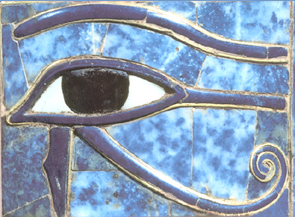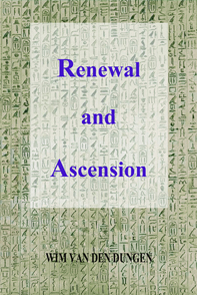|
"Our constitution is called
democratic, because power lies not in the hands of a minority, but in the
largest possible majority." -
Thucydides II, 37.
Ancient Egypt was not a democracy, but a theocracy. It did not have
a free market economy, but a plan economy. One man was in
power and considered to be a divine king : Pharaoh. Daily, he offered Maat to Re in order to make this
state of affairs endure for ever. All resources of the Pharaonic State
were aimed at "eternalizing" the Dynastic Rule. Pharaoh
initiated gigantic construction projects, was officially the highpriest of
all of Egypt's numerous tempels, and maintained a closed government
redistributive system based on a well organized administration. Egypt's economy was
rooted in agriculture, but private
ownership did exist (a parallel economy is thus also likely).
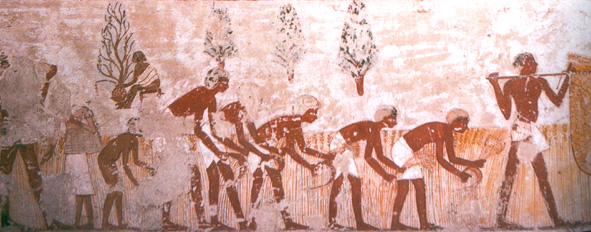
Tomb
of Menena - Thebes - XVIIIth Dynasty ca.1390 BCE.
Educated guesses (Davies,
1995) suggest that less than 1 per cent of the total population
would have been literate during most of the Pharaonic Period (rising to
ca. 10 per cent when Greek had become the official language of Egypt).
Hence, our philosophical and esoteric studies are largely based on the
culture of the upper classes (10 per cent - cf. Veblen), imitated and
popularized by the lower.
Although, on the one hand, our knowledge about the common Egyptian has
increased, it is clear no other objective material is present than
what can be found thanks to archaeological research, and, compared to the
literate sources, this remains quite thin. On the other hand,
inscriptions, objects of art & magical representations were idealized, telling us more about the projected lifestyle of Pharaoh and the deities,
than being a faithful record of how wealthy Egyptians lived their lives
(for example, Pharaoh Tutankhamun's tomb contained objects never seen
before elsewhere). Indeed, "history" was largely honorific and
endowed with magico-religious meaning. But, again, one should stress the
fact that, compared to
Archaic Greece, Ancient Egypt left us
a wealth of sources.
Most Egyptians lived in homes (or rather hovels) that contained the bare
necessities of life. People had no bed or no chair and sat or slept on the
floor. Alcohol and opiates made life more appealing. Every home contained
beer, fish, fowl, onions, dates, clay pottery, a copper or stone knife, a
bone needle, flaxen thread and a comb. Flour was ground with a stone and
bread was baked flat like the Middle Eastern bread of today.
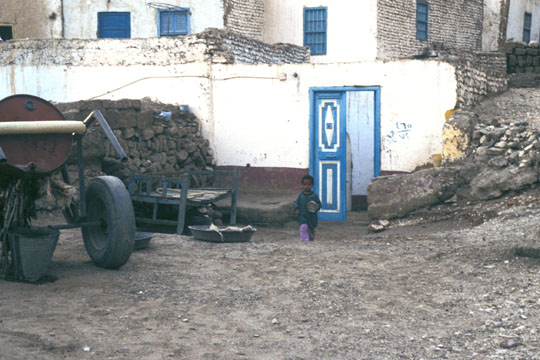
Village
near Luxor - 2002 CE.
The fortunate were Pharaoh and his court, his literate administators &
priests and those subordinate to them (doorkeepers, soldiers, quarrymen,
artists and crafsmen etc). Among these ranks we find the use of perfumes, cosmetics,
a sit-down toilet, scolls, oil-burning lamps, footwear, gloves, salt and
pepper, honey, wines, a chariot, board games, tweezers, spoons, animals,
wigs, musical instruments, meat, fine clothes, time measurement, servants,
slaves, etc.
Each morning, Pharaoh and the gods would be wakened by
courtiers and priests with songs and hymns of praise dedicated to the
protectors of Upper and Lower Egypt, the vulture-goddess Nekhebet and the
cobra-goddess Wadjet (cf. "Hymn of Rising").
This divide between the fortunate and the illiterate peasantry was not
questioned, for society was viewed as static and based on the patrilineal
principle (from father to son, etc). The whole of Antiquity was
characterized by such gross inequalities. The causes of inequality were
institutionalized in a pyramidal model, expressing a continuous
harmonization & rebalancing, eternalized in and by the divine king,
who faced the deity directly and alone.
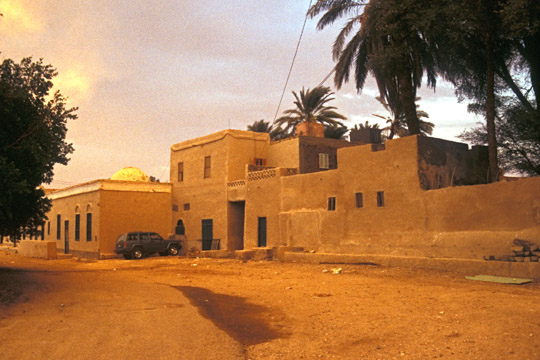
House
near Luxor - 2002 CE.
"The essence of Maat in the human sphere was not perfect social and
economical equality but rather the harmonious coexistence of society's
different levels. Maat did not mean that the rich and powerful should
become equal to the poor and weak, or vice-versa. (...) Instead, Maat
meant that the rich and powerful should use their advantages not to
exploit those less fortunate but rather to help them." -
Allen,
2000, p.116.
In the course
of these studies, a number of changes in the way the Ancient Egyptians
viewed Pharaoh, the gods and the commoners have been encountered. This
provisional table tries to summarize these shifts (from Predynastic until
the end of the New Kingdom) :
|
Pharaoh |
Pantheon |
People |
Pre-
Dynastic |
In the Terminal Period,
we find evidence of the rule of local chiefs and the rise of the kingdoms of
Upper Egypt, uniting & conquering the rest of Egypt .
The unification of Egypt is the triumph of the mythical notion of
divine kingship, a dual monarch, able to assimilate the sacred
feminine (of nature), effectively ending the Neolithic phase by making the myth
of the Great Goddess part of the
genesis of himself, justifying his masculine kingship, namely as the
"wive of
the king", the "mother of the king" or the "sister of
the king" |
Regarding the composition
of the pantheon, nothing can be said. But the "great powers" of nature
were the multiform manifestations of the sacred, associated with major
"hidden" and "mysterious" processes, such as fecundity, pregnancy,
birth, growth, health, regeneration, a good death and a happy
afterlife. Hathor as Great Goddess of the sacred. Horus appears in the
Terminal Period. It is probable that polytheism was prevailing. Each &
every deity being a great manifestation of the powers of nature, a
being unique in its kind with a control over a particular area of life
& death. Only the flow of life itself was permanent. |
Starting with simple,
local Neolithical settlements, larger agricultural areas got
integrated as soon as traffic of on the Nile increased, allowing for
exchanges of all kind and the realization of the fundamental unity of
Egypt thanks to the Nile and its yearly gift of black Earth. The
organization of larger territories and their various administrations
can be observed in Amratian culture (Naqada I). The rise of societies
with a central, royal authority is attested in Gerzean culture (Naqada
II). Social strata reflect in funerary practices. Of course, only
circumstancial evidence exists, and as such, direct information
about commoners is sparse to nonexisting. |
Early
Dynastic |
Pharaoh united the Two Lands as a
divine power, a manifestation of Horus. He was the top of the social
pyramid and the only reason why the relapse into chaos did not
happen.
He was not yet divine in an by
himself, but and incarnation, the "best" place for the divine power
to dwell in. Pharaoh was a "Follower of Horus". |
The polytheism of the nomes (the area
of operation of a deity, its place to be) was for the first time
superceded by an active, centralizing and dominating deity : Horus.
Moreover, his name was written down.
The Great Goddess had been passive, pre-historical & diffuse. Horus
incarnating as Pharaoh united Egypt's divisions : the harmony of
opposites. |
The late Predynastic system was
enhanced by the invention of writing, causing the advancement of
Egyptian civilization.
A layered society emerged : a rather
thin (ca.10%), but well-organized, bureaucracy around Pharaoh and his
Residence, on top of a vast underlayer of illiterate farmers, laborers
and common craftsmen, proficient in their work. Probably only 1% was
literate. |
Old
Kingdom |
Pharaoh was the only son of the
creator Re. As the spirits of the deities abided in the sky (of the
North), Pharaoh was the only god "on Earth". He was the sole
mediator in who's name the temples of Egypt offered to the pantheon.
In this way, Pharaoh returned truth
& justice ("Maat") to his father Re. With the exception of Re,
Pharaoh was more powerful than the pantheon. At his death, Pharaoh
returned to the Northern sky, to exist with the lightbeings of the
circumpolar stars. There he existed with Re forever. |
The
gods and goddesses appear in constellations which express their
various multiple interactions, actively ritualized in the temple of each
nome. But national deities rise : Atum-Re (Iunu), Ptah (Mennefer) and
Osiris. They are all linked with Pharaoh, the only god with direct
power on Earth. The Heliopolitans dominated and proposed a creator
who creates himself in the beginning (Atum) and ejects creation out
of his body. In the
Memphite theology, the
creator created by means of divine
words
thought, spoken and written (manifested). |
The ability to organize
the resources of Egypt is formidable. Enduring common efforts to erect
pyramids and other monuments stand erect today.
Deceased commoners could at
best hope to "hide" as justified in the sky (of the
Beautiful West). The closer they had been to Pharaoh, the more
likely their happy afterlife was. Usually, their names got lost.
Numerous festivals enabled them to witness the glory of Pharaoh's
rule directly. Access to and service in (parts of) the temple was
also common. |
|
First
Intermediate |
The unity of Egypt
was
lost. Famine and civil war had occured. The country was divided.
The identity between Pharaoh & the political order was
fully broken and provincialized. On the other hand, Pharaoh
remained the exclusive divine mediator, son of Re.
As Lower &
Upper Egypt were at war, each victor would promote "his"
god to justify his kingship. |
The collapse of the
kingdom meant the end of a national cult (as that of Re or Ptah) and
the power of Iunu and Mennefer. As a result, one returned to the
deities of the nomes. The burial
customs reveal the importance of interpersonal relationships in the
afterlife. The priesthood attached to the temples formed a
provincial élite. The provincial magnates linked their power with
these cults to gain local approval. |
A thriving culture
existed among the poorer levels of society and a clear social
development in the towns of Upper Egypt. The "collapse" of
the Old Kingdom was the "end" of the old bureaucracy to
the advantage of the provinces (cultural activity had been
Memphis-based). The provincial milieu fostered a family-life in a
loose urban structure, with the heads of the families as final
authority. |
Middle
Kingdom |
The
Theban nomarchs united Egypt and (when leaving Thebes) introduced
Amun as their state god. Although
the nomarchs assumed the Pharaonic titulary, the kingship was less
centralized and a kind of feudal organization prevailed (with
taxations). Pharaoh's Osirian aspect was clearly emphasized. With it
rose the importance of regeneration, magic and resurrection. |
The decentralization
did not last. Amun assimilated Re and the conflict between Re and
Osiris was solved. As a result, a state religion saw the light
again, this time with Amun-Re as "king of the gods" and
"divine judge". Osiris is the "Sun of the netherworld", yet another face of Amun-Re. Yet, the scepsis and
"pessimism" of the earlier period becomes a literary
genre. Everybody may become an Osiris-NN. |
The emerging
individualism grew. The non-royal as well as commoners had a
soul, not only Pharaoh. As a result, every deceased could (assisted
by the proper funerary rituals and coffin spells) be justified.
This depended no longer on one's merits in the divine eyes of
Pharaoh, but exclusively on the lightness of one's own mind &
conscience. This feudal religious humanism fed fears expelled through
magic. |
Second
Intermediate |
Egypt's unity was lost
again. Nomadic tribes infiltrated the eastern Delta
("Aziatics"). The kings of foreign lands
("Hyksos") settled in Avaris. The land was divided again in
North (Lower) & South (Upper). |
In the South, Amun-Re
was worshipped, but the Hyksos take over Seth. The division
between Horus (Re) and Seth is again apparent. They claim Egypt with
vassals in Thebes. They were expelled as far as Palestine.
|
The Egyptians adopt
foreign forms, ideas, concepts and art. The Hyksos brought the horse,
the chariot and the composite bow. This paved the path for the
flowering of the international humanism of the New Kingdom.
|
New
Kingdom |
With the
reunification of Egypt by the Thebans, the original power of the
ideal of Pharaoh was restored and again kings were deified.
Egypt
was now conceived as the center of the world and Pharaoh as the
center of Egypt. The Amarna event being an extreme example of the
principle. But after Amarna, Pharaoh lost his central position for
good, for the gods embodied kingship.
Pharaoh was now subjected to
their will too. In need, Pharaoh would appeal to Amun. |
Introduction of the
New Solar Theology and its focus on the course of Re hand in hand
with the rest of the pantheon.
Amarna theology caused a crisis which made Amun-Re rise as the
unquestioned king of the pantheon, the god of gods who existed far
and near. But although his divinity was still being emphasized in
the vast monumental record, Pharaoh was no longer the "god in
charge" but a representative of Amun on earth. Hence, political
power was slowly transferred to Amun's large priesthood who could
read Amun's oracle. |
The international
humanism of Egypt peaked. But under Akhenaten, the Egyptians were
forced to relinquish the pantheon, with as result the complete
interiorization of their adherence to it. After Amarna, the central
position was taken in not by the king but by the god. When evil was
done, divine intervention could punish an individual. More and more
the will of Amun-Re became the most important factor in religious
life. The mummies of royals were no longer divine, and so could be
unwrapped. All depended on Amun's will. |
|
